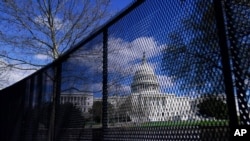Law enforcement concerned by the prospect of violence at a rally in the nation's capital next week are planning to reinstall protective fencing that surrounded the U.S. Capitol for months after the January 6 insurrection there, according to a person familiar with the discussions.
Though no specific measures have been announced, House Speaker Nancy Pelosi hinted during her weekly press conference Wednesday at extra safety precautions for the September 18 rally by saying: "We intend to have the integrity of the Capitol be intact."
Some lawmakers and top union officials were expected to be briefed on the plan later this week, and another more expansive briefing for the leaders of the House and Senate was planned for Monday.
A security plan that is being finalized calls for fencing to be put up outside the inner perimeter of the Capitol building and the Supreme Court, though not around the congressional office buildings nearby, said the person, who spoke to The Associated Press on condition of anonymity ahead of an official announcement.
'Justice' for those charged
Police continue to track intelligence indicating far-right extremist groups like the Proud Boys and Oath Keepers are planning to attend the rally this month at the U.S. Capitol that is designed to demand "justice" for the hundreds of people who have been charged in connection with January's insurrection. Proud Boys leader Enrique Tarrio, however, has said he doesn't expect his membership to attend.
The planned presence of the extremist groups is concerning, because while members and associates of Oath Keepers and Proud Boys make up just a small fraction of the nearly 600 people who have been charged so far in the riot, they are facing some of the most serious charges brought.
The fence had been a stark symbol of the fear many in the Capitol felt after the mob pushed its way past overwhelmed police officers, broke through windows and doors, and ransacked the Capitol as Congress was voting to certify Joe Biden's electoral win.
Those charges include allegations that they conspired to block the certification of Biden's victory. Several Oath Keepers have pleaded guilty to conspiracy charges and are cooperating with investigators in the case against their fellow extremists, who authorities say came to Washington ready for violence and willing to do whatever it took to stop the certification of the Electoral College vote.
The planned September 18 rally at the Capitol comes as a jittery Washington has seen a series of troubling one-off incidents — including, most recently, a man who parked a pickup truck near the Library of Congress and said he had a bomb and detonator.
And the most concerning: Unexploded pipe bombs placed near the Capitol ahead of the January 6 insurrection remain unexplained, and no suspect has been charged.
The FBI released a new video of that suspect on Wednesday and a digital map showing the person circling the offices of the Democratic and Republican national committees, where the bombs were placed. The FBI also said for the first time that agents believe the suspect is not from the Washington, D.C., area but may have been "operating" out of a location near the Capitol.
"Based upon the suspect's route of travel to the DNC and from the DNC to the RNC, and the manner in which the suspect carries the backpack after placing the pipe bomb at the DNC, the FBI believes the suspect had a location in the vicinity of Folger Park from which the person was operating," the FBI said in a news release. "Reviews of the suspect's behavior in video footage and interviews with residents in the Capitol Hill neighborhood have led the FBI to believe the suspect is not from the area."
What deserves to be fenced?
On Capitol Hill, the politics around fencing in the iconic building and its grounds were extremely difficult for lawmakers after the January 6 insurrection. Many said they disliked closing off access, even as they acknowledged the increased level of security it provided. The fencing finally came down with a promise to re-erect it if necessary. But the question of what deserves fencing is tricky.
In an interview Wednesday, the District of Columbia’s Democratic representative, Delegate Eleanor Holmes Norton, said that she had not yet been briefed on the security plans, but that she understood if the fence needed to be reinstalled out of an abundance of caution ahead of the upcoming rally.
"I would hope that we wouldn't have to fence in the Capitol every time there's a demonstration," Norton said. But she added, "If they go with the fence, I'm not going to criticize them."
Norton suggested that in the aftermath of January 6, there would be more robust security preparations ahead of this rally out of an abundance of caution, even though it is scheduled for a Saturday before the House returns to session, a typically sleepy summertime afternoon when few lawmakers or staff would be at work.
"I wouldn't be surprised to see the fence go up," she said. "The preparations are certainly going to be more than they were on January 6."











